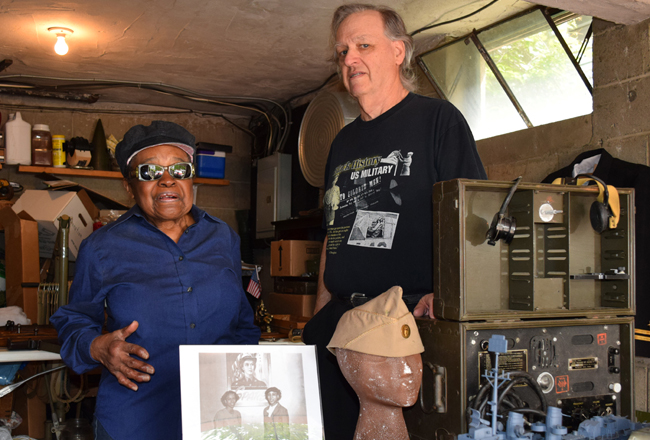
It is not unusual to find esoteric objects stored in a garage, but anyone taking a casual peek into the garage at the Stamford home shared by Mabel Jorgensen and Bruce W. Bird will find something rather unusual: a wealth of World War II-era uniforms, nonfunctioning artillery shells, rifles and intricate models of fighter planes and battleships, along with photographs showing young African-American men and women in uniform who proudly served their country despite the harshness of Jim Crow segregation.
The garage collection is but a sample of the thousands of objects and photographs assembled by Bird for his Museum of Black World War II History. The museum was originally operated in a small Vermont town between 2006 and 2011, and Bird and Jorgensen are on a mission to reopen it either in Stamford or another Connecticut location.
Bird was a factory worker in Vermont with a keen interest in military history and an extensive collection of World War II paraphernalia. A back injury took him out of the factory and during his recovery period he returned to school to receive a bachelor”™s degree in history from North Adams State College, now the Massachusetts College of Liberal Arts. He combined his longtime interest in military history and degree in a new job as curator at the Vermont Militia Museum until a chance discovery of a book on what was to Bird an obscure chapter of World War II set him on a new journey to learning.
“I saw a book by Kareem Abdul-Jabbar about the 761st Tank Brigade,” he recalled, referring to the 2004 book, “Brothers in Arms: The Epic Story of the 761st Tank Battalion, WWII’s Forgotten Heroes,” which the basketball Hall of Famer co-wrote with Anthony Walton. “And I said to myself, why don”™t I know this? There were 1.1 million blacks who served in World War II and I knew nothing about it.”
Bird added items tied to the African-American experience in World War II to his collection, including photographs and objects connected to the 761st battalion, the legendary Tuskegee Airmen, the European-based 6888th Central Postal Directory Battalion that consisted entirely of black women, and individual heroes of the conflict. In 2006, he was ready to launch his own museum devoted to the subject of African-American involvement in World War II.
“I sold my home and cashed in my retirement money,” he recalled, using those funds to self-finance his museum in the town of Pownal, Vermont. He secured a disused two-room 19th-century schoolhouse for his museum for a $1 annual rent, but the cost of maintaining the facility quickly became perilous. Structural repairs to the building”™s roof and other upgrades ultimately cost Bird $40,000 and the notorious Vermont winters only added to his woes.
“When I started in 2006, the fuel bill was $1.69 (per gallon),” he said. “It was $3.89 at highest point. I was bled dry by the oil company.”
It also did not help that the museum was too far under the tourist radar to create a return on Bird”™s investment. “I had 200 visitors a year and took in $1,000,” he said. “It was in an out-of-the-way place.”
One person who did find the museum was Jorgensen, a retired physician”™s assistant who was in Vermont in 2006 at a breast cancer survivors’ retreat. An African-American whose late husband was a World War II veteran and whose brother served in the Army during the war, Jorgensen initially was astonished to find a black history museum in a rural area with very few nonwhite residents.
“I thought to myself, what is a white man doing in a black museum?” she said, recalling her initial reaction to Bird. When financial problems forced Bird to close the facility in 2011, Jorgensen invited him to relocate to her Stamford home with the goal of reopening the museum in Connecticut. Bird brought some of his collection to Jorgensen”™s home and kept the remainder in storage in Vermont.
In the ensuing six years, the two have made repeated efforts to secure a Stamford location for the museum. Negotiations with Stamford city government were initially encouraging but no satisfactory location or agreement was ever achieved.
“The city of Stamford talked about the old recreation center on Cortland Avenue, right by Exit 9 (on Interstate 95),” Bird said. “But that would cost $5.9 million. If I had $5.9 million, I”™d have four different museums in four different states.”
Bird was hopeful that he could find another donated building as he did in Vermont, but he”™s aware that Fairfield County”™s pricey real estate market is very different from rural Vermont”™s. “We”™re looking for 5,000 square feet, but we would take a storefront and make it work,” he said.
For now, Bird offers pop-up displays from his collection around Stamford. He was in the lobby of the liquor retailer BevMax in February and the Stamford Government Center in May while soliciting funds for his museum endeavor. Jorgensen said they were in conversations “with several locations” both in and outside of Stamford about a new home for the museum.
Bird said he does not intend to donate the collection to an existing institution and relinquish his project.
“I want to do something,” he said. “I”™m retired. I can sit back and do very little or have a project. My mind still works, the body is tolerably working. And I enjoy it. I learn more about the black experience every day. I”™m having a ball.”






















